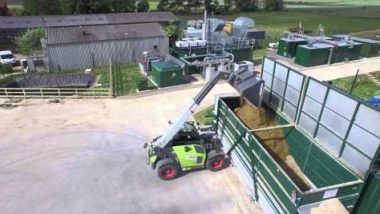The term “biogas digester” can describe any anaerobic digestion process. It is most associated historically with the brick built types of buried fixed Dome Biogas Digester.
This type of biogas digester is very common in many developing nations, but new types of plants, can be much better. So, here are four Biogas Digester facts you can benefit from:
1. How is Biogas Produced?
Free energy in the form of methane gas from your own food waste is produced by feeding organic waste (like stale/ inedible food) into a biogas digester.
It is one of the most practical and cost effective ways to generate alternative, sustainable and environmentally friendly energy, and works especially well in hot countries. It is made by fermenting organic matter (biomass) in closed vessels.
2. How Much Biogas is Produced by a Well Operated Biogas Digester
The average amount of biogas made for every kilogram of waste put into the biogas digester is half a cubic metre, enough to power a light globe for about 90 hours. This is not an insubstantial amount of energy.
3. Biogas Digester Design Facts About the Plant Type You Might Use
Fixed Dome Biogas Plants
 A fixed-dome plant comprises of a closed, dome-shaped digester with an immovable, rigid gas-holder and a displacement pit, also named ‘compensation tank'. The gas is stored in the upper part of the digester. When gas production commences, the slurry is displaced into the compensating tank. Gas pressure increases with the volume of gas stored, i.e. with the height difference between the two slurry levels. If there is little gas in the gas-holder, the gas pressure is low.
A fixed-dome plant comprises of a closed, dome-shaped digester with an immovable, rigid gas-holder and a displacement pit, also named ‘compensation tank'. The gas is stored in the upper part of the digester. When gas production commences, the slurry is displaced into the compensating tank. Gas pressure increases with the volume of gas stored, i.e. with the height difference between the two slurry levels. If there is little gas in the gas-holder, the gas pressure is low.
Floating Drum Digester Plants
Floating-drum plants consist of an underground digester and a moving gas-holder. The gas-holder floats either directly on the fermentation slurry or in a water jacket of its own. The gas is collected in the gas drum, which rises or moves down, according to the amount of gas stored.
Low-Cost Polyethylene Tube Digester
The Low-Cost Polyethylene Tube Digester model consist of tubular polyethylene film (two coats of 300 microns) bent at each end around a 6 inch PVC drainpipe and is wound with rubber strap of recycled tire-tubes.
Balloon Digester Plants
A balloon plant consists of a heat-sealed plastic or rubber bag (balloon), combining digester and gas-holder. The gas is stored in the upper part of the balloon. The inlet and outlet are attached directly to the skin of the balloon.
Earth-pit Digester Plants
Masonry digesters are not necessary in stable soil (e.g. laterite). It is sufficient to line the pit with a thin layer of cement (wire-mesh fixed to the pit wall and plastered) in order to prevent seepage.
The edge of the pit is reinforced with a ring of masonry that also serves as anchorage for the gas-holder. The gas-holder can be made of metal or plastic sheeting.
If plastic sheeting is used, it must be attached to a quadratic wooden frame that extends down into the slurry and is anchored in place to counter its buoyancy.
The requisite gas pressure is achieved by placing weights on the gas-holder. An overflow point in the peripheral wall serves as the slurry outlet. via energypedia.info
4. Fact: Food Waste Processing in a Biogas Digester is Valuable at Many Levels
Biogas technology is one of the best solutions for the control of waste, and importantly, it can be used as a reliable 24/7 “always on” power renewable energy source. So, unsurprisingly there is now a strong willingness to develop renewable energy solutions, not least to reduce the worst effects of global warming, and the importance of biogas is growing globally.
It was recently stated by the UK organisation ADBA (See the ADBA_Letter_to_Robert_Jenrick_MP), that measures to increase food waste recycling by AD will:
a) reduce [UK national] methane emissions and help meet [UK national] Carbon Budgets at a comparatively low cost;
b) produce renewable energy, critically in the form of an ultra-low carbon gas, also contributing to a low carbon economy; and
c) recycle soil nutrients and organic matter which will contribute to improved carbon sequestration in soil, 40% of the world's soils are suffering from erosion and part of the cause is a lack of organic carbon, this can be countered by the high quality digestate that is a by-product of anaerobic digestion.
The basis for the claim that biogas use is sustainable comes from the fact that it's production and use is considered to be CO2-neutral when done right. That means that it does not give rise to an increase in the volume of greenhouse gases.
The larger manifold impact of biogas use is in decentralized energy production and provision, reduction of energy imports resulting in increased profits and increase in security of energy supplies.
Conclusion
The biogas digester which has been built most in countries such as China and India is the Fixed Dome Biogas Digester, which is buried and built from stone, and millions have been built in China alone.
In recent years small domestic biogas digesters have been developed which are low cost, and and example is the balloon AD plants which made from plastic and can be a great DIY project, and operated in an average back-yard.
Generally around the world, biogas use is increasing (driven by the Renewable Energy Directive, in Europe). European governments are supporting renewable energy.
They need to achieve heat and transport related targets as well as raising electricity generation from renewable sources in order to comply with climate change reduction objectives.
But, even where there is no government support many people find that it pays to utilize biogas for cooking, heating, farm level electricity generation, in conjunction with organic waste recycling.
Not only that it can also provide for biofertilizer production, waste disposal, veterinary sanitation, odor removal, and GHG emissions reduction.
Now you have learnt these impressive facts about biogas digesters! We hope you will, in future, support bio-digestion in your area. Please give us your comments.
Further Information on how to Start a Home Biogas Digester Project
How much does a small/ home biogas digester cost
If you have a budget of $500 to $1,000 you can search for a “biogas digester for sale”, order a small biogas digester and follow the instructions when the digester arrives.
That's about how much the newest generation of home digesters cost.
For those that have a smaller budget, or just like the challenge of a DIY project, they can learn how to build a biogas digester from first principles by studying webistes online.
They can watch videos on the types of biogas digester which are available, and choose the type of digester, such as a balloon style home biogas digester. Alternatively, there is always the option of downloading a biogas digester pdf.






Good to highlight & point people to an alternative to the common home composting of organic waste (including foodwaste, which our council warns it’s taxpayers of the potential for vermin from protein inclusions!), but I think you might have also mentioned the interesting Israeli domestic design (https://homebiogas.com/) that had an introductory price here of around £600! However, as I have already informed the company it will need to have additional features for UK & Europe e.g. total light steel enclosures (instead of plastic!), a gas leakage sensor & simple battery-backed alert/alarm.
Brian. Yes. These are all good points. There is a danger that these plants if not well designed with gas-leak monitoring would result in so much methane loss to the atmosphere that the net reduction in Greenhouse effect would be nil! Similarly, it’s no good if the digester leaks and pollutes groundwater or drains into a local stream. I believe that WRAP did some work on home composting and again the concern was that poor home composting with saturated over-wet composting results in methane discharges.
Further to my comment above, the company has just launched an associated home biotoilet (https://homebiogas.com/blog/the-new-bio-toilet-a-bloggers-review/) and donated a dozen to the Guatemalan community development project (see link on same page).